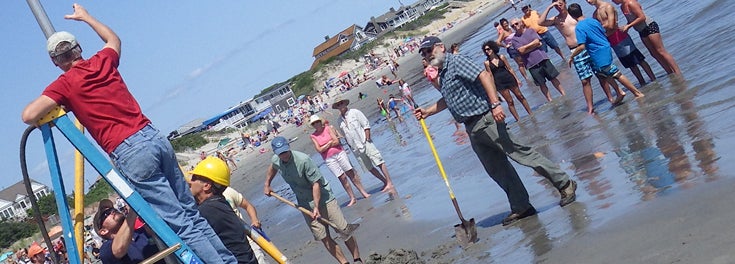
When you’re sitting on a crowded beach enjoying the summer sun, the last thing you expect to happen is an explosion that blasts you out of your beach chair. But if it does, who you gonna call? If you’re smart, you call URI’s Graduate School of Oceanography.
That’s exactly what happened last summer when a visitor was injured by an unknown explosion beneath the sand at Narragansett’s Salty Brine State Beach. State officials contacted the University when police and the bomb squad couldn’t figure out what caused the incident. It didn’t take long before our faculty and students had solved the bizarre mystery.
As beachgoers and the media watched, URI oceanography professors with expertise in coastal geology and the chemistry of ocean sediments got to work, collecting several sediment cores up to 5 feet deep from the area where the explosion happened.
As beachgoers and the media watched, URI oceanography professors with expertise in coastal geology and the chemistry of ocean sediments got to work.
Back at a lab at the Narragansett Bay Campus, graduate students Justine Sauvage and Kira Homola worked long hours slicing up the cores, collecting gas samples from the sand, and injecting it into a gas chromatograph.
Professor Art Spivack said the researchers were lucky to have Justine on the team. She has become an expert on the analysis of hydrogen in sand and sediments and “one of a handful of people in the country who could just walk on the scene and do the work. We were uniquely capable of responding to this situation because of her skills,” he said.
When Professor Spivack looked at the results of the gas chromatography, he knew he had the answer. It showed exceptionally high levels of hydrogen in a few pockets just beneath the area of the explosion, far higher levels than Justine had ever previously measured. Hydrogen is typically recorded at just a few parts per million, but in the beach sand there were up to 50,000 parts per million, and that quantity could easily have become flammable and exploded. Mystery solved.
But that’s not the only mystery that URI faculty, staff and students have been called upon to help solve. When major oil spills happen, Ocean Engineering Professor Malcolm Spaulding is asked by the Coast Guard and other agencies to help track the path the oil is likely to travel, based on winds and currents. When terrorist bombs explode, Chemistry Professor Jimmie Oxley is often engaged by the FBI and their counterparts around the world to determine the chemical make-up of the bomb. And when a judge required that the rifle that was used to shoot Martin Luther King Jr. needed additional testing, he looked to the State Crime Lab in the College of Pharmacy. URI scientists were even involved in a study of baseballs not long ago to determine why so many home runs were being hit.
So if you’re a fan of mysteries—or wonder where to turn for answers when mysteries arise—think URI. It’s the place to go.
